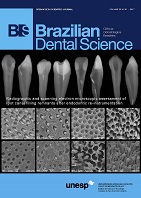Influence of Different Obturation Systems on the Fracture Resistance of Endodontically Treated Roots
DOI:
https://doi.org/10.14295/bds.2017.v20i1.1348Abstract
Objective: This study aimed to compare the fracture resistance of endodontically treated roots filled by different obturation systems. Material and methods: Ninety-six upper central incisors were used and decoronated, retaining 12 mm of the roots. On the basis of obturation systems, the roots were divided into 4 groups (n=24): Group1 (COGR): control group (unprepared, unfilled), Group 2 (AVGR): ActiV GP points/ActiV GP sealer, Group3 (GPGR): Gutta percha points/AH plus sealer, and Group4 (GAGR): Gutta percha points/ActiV GP sealer. The last three groups were obturated with the single cone technique. The roots were then stored in 100% relative humidity at 37 °C for 2 weeks. A vertical compressive force was exerted with a universal testing machine until a fracture occurred. Data were statistically analyzed with one-way ANOVA. Results: Mean (SD) failure loads for groups ranged from 920.51 ± 210.37 to 1113.44 ± 489.42 N. The fracture resistance between the different study groups indicated no statistical difference. Conclusions: ActiV GP system did not exert a significant effect on the fracture resistance of endodontically treated teeth.
Downloads
Downloads
Published
How to Cite
Issue
Section
License
Brazilian Dental Science uses the Creative Commons (CC-BY 4.0) license, thus preserving the integrity of articles in an open access environment. The journal allows the author to retain publishing rights without restrictions.
=================




























